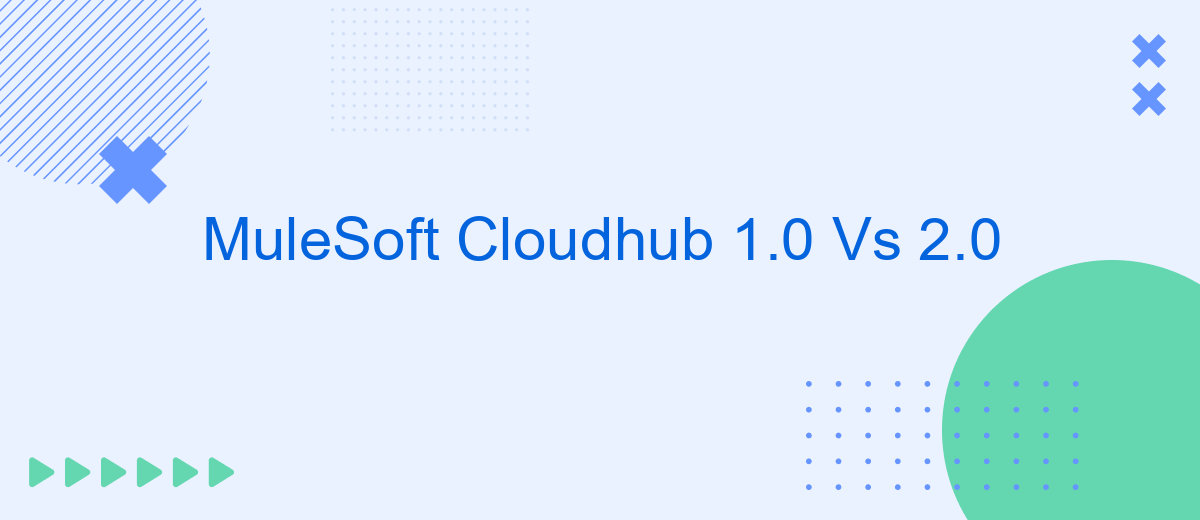MuleSoft Cloudhub, a robust integration platform, has undergone significant advancements from version 1.0 to 2.0. This article explores the key differences and improvements between Cloudhub 1.0 and 2.0, highlighting enhanced performance, scalability, and new features. Whether you're a current user or considering a transition, understanding these updates will help you leverage the full potential of MuleSoft's cloud-based integration solutions.
Introduction
MuleSoft Cloudhub is a widely used integration platform that enables organizations to connect their applications, data, and devices seamlessly. With the release of Cloudhub 2.0, many are curious about the improvements and changes from the previous version. This introduction aims to provide a comparative overview of Cloudhub 1.0 and 2.0, highlighting their key features and advancements.
- Scalability and Performance Enhancements
- Improved User Interface and Experience
- Advanced Security Features
- Enhanced Integration Capabilities
Understanding the differences between Cloudhub 1.0 and 2.0 is crucial for businesses looking to optimize their integration strategies. For instance, services like SaveMyLeads can be leveraged to automate and streamline lead management, further enhancing the efficiency of integrations. This section will delve into the specific enhancements and how they can benefit your organization.
Features Comparison

MuleSoft Cloudhub 1.0 and 2.0 both offer robust integration capabilities, but they differ significantly in terms of features and performance. Cloudhub 2.0 introduces advanced scalability options, allowing businesses to handle larger volumes of data and more complex integration scenarios. Additionally, Cloudhub 2.0 boasts improved reliability and uptime, ensuring that critical business processes remain uninterrupted. These enhancements make Cloudhub 2.0 a more suitable choice for enterprises with demanding integration needs.
Another key difference is the enhanced user interface and user experience in Cloudhub 2.0, which simplifies the process of managing and monitoring integrations. This is particularly beneficial for businesses utilizing services like SaveMyLeads to automate their workflows and data synchronization. With Cloudhub 2.0, users can more easily configure and deploy integrations, reducing the time and effort required to maintain seamless data flows. Overall, Cloudhub 2.0 offers a more powerful and user-friendly platform for modern integration needs.
Pricing and Plans

MuleSoft Cloudhub 1.0 and 2.0 offer flexible pricing plans designed to cater to different business needs. Both versions provide a range of options to help organizations effectively manage their integration solutions without overspending.
- Basic Plan: Ideal for small businesses, this plan offers essential features at an affordable price.
- Standard Plan: Suitable for mid-sized companies, it includes additional resources and support.
- Enterprise Plan: Tailored for large organizations, this plan provides advanced features and premium support.
- Custom Plan: For businesses with unique requirements, a custom plan can be created to meet specific needs.
In addition to these plans, services like SaveMyLeads can further enhance your integration experience by automating lead processing and other essential tasks. This ensures that your MuleSoft environment remains efficient and scalable, allowing you to focus on core business objectives.
Use Cases

MuleSoft Cloudhub 1.0 and 2.0 offer robust platforms for managing integrations, but their use cases can differ based on specific business needs. Cloudhub 1.0 is well-suited for legacy systems and organizations that require a stable, time-tested environment. On the other hand, Cloudhub 2.0 is designed for modern, scalable applications that demand higher performance and flexibility.
Businesses can leverage MuleSoft Cloudhub 2.0 for more advanced, cloud-native integrations. This version offers enhanced capabilities such as better scalability, improved performance, and more efficient resource management. For instance, companies aiming to streamline their customer relationship management (CRM) systems can benefit from the advanced features of Cloudhub 2.0.
- Real-time data synchronization between multiple systems
- Enhanced API management and monitoring
- Seamless integration with third-party services like SaveMyLeads
- Automated workflows and reduced manual intervention
In summary, while both versions of MuleSoft Cloudhub are powerful tools for integration, the choice between them depends on the specific requirements of the business. Cloudhub 1.0 remains a reliable choice for traditional setups, whereas Cloudhub 2.0 provides the agility and efficiency needed for modern, dynamic environments.
Conclusion
In conclusion, the transition from MuleSoft Cloudhub 1.0 to 2.0 represents a significant leap forward in terms of performance, scalability, and security. Cloudhub 2.0 offers enhanced capabilities that cater to modern integration needs, making it a more robust and efficient platform for businesses looking to streamline their operations. The advanced features such as improved deployment options and better resource management ensure that organizations can handle more complex integrations with ease.
Furthermore, tools like SaveMyLeads can complement the functionalities of MuleSoft Cloudhub 2.0 by simplifying the integration process even further. SaveMyLeads provides an intuitive interface for setting up automated workflows, allowing businesses to connect various applications without the need for extensive coding knowledge. This synergy between MuleSoft Cloudhub 2.0 and SaveMyLeads can greatly enhance an organization's ability to manage and optimize their integration landscape, ultimately driving better business outcomes.
- Automate the work with leads from the Facebook advertising account
- Empower with integrations and instant transfer of leads
- Don't spend money on developers or integrators
- Save time by automating routine tasks
FAQ
What are the main differences between MuleSoft CloudHub 1.0 and 2.0?
Can I migrate my existing integrations from CloudHub 1.0 to CloudHub 2.0?
Is there a cost difference between CloudHub 1.0 and CloudHub 2.0?
How does CloudHub 2.0 improve integration automation?
What support options are available for CloudHub 2.0?
Are you using Facebook Lead Ads? Then you will surely appreciate our service. The SaveMyLeads online connector is a simple and affordable tool that anyone can use to set up integrations for Facebook. Please note that you do not need to code or learn special technologies. Just register on our website and create the necessary integration through the web interface. Connect your advertising account with various services and applications. Integrations are configured in just 5-10 minutes, and in the long run they will save you an impressive amount of time.

